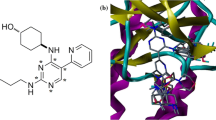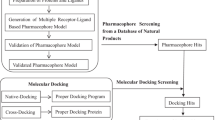Abstract
Matrix metalloproteinase-9 (MMP-9) is one of the important enzymes belongs to gelatinase family and involved in multiple cellular processes including proliferation, angiogenesis, and metastasis. Various studies show that N-substituted homopiperazine barbiturates are promising and also selective for the MMP-9 inhibition. In this study, we selected and reported 49 barbiturate derivatives as inhibitors of MMP-9 and performed structure-based 3D-QSAR studies to elucidate the important structural features responsible for binding affinity. Crystal structure of MMP-9 complexed with barbiturate available in PDB was selected and performed quantum-polarized ligand docking for the reported inhibitors. Receptor-based alignment obtained from the docked poses were used for field- and Gaussian-based 3D-QSAR study. The results of both field and Gaussian models gave the good predictive correlation coefficient (test set) q 2 of 0. 77 and 0.85, and the conventional correlation coefficient (training set) r 2 of 0.845 and 0.928, respectively. The results of 3D-QSAR and docking studies validate each other and provided insight into the structural requirements for MMP-9 inhibition. The outcomes of the contour maps for both steric and Gaussian models results indicate that steric and hydrophobic interactions are major contributing factor for the activity and these findings will be useful to design the new inhibitors against MMP-9.







Similar content being viewed by others
References
Aparna V, Jeevan J, Ravi M, Desiraju GR, Gopalakrishnan B (2006) 3D-QSAR studies on antitubercular thymidine monophosphate kinase inhibitors based on different alignment methods. Bioorg Med Chem Lett 16:1014–1020
Bairy SK, Suneel Kumar BV, Bhalla JU, Pramod AB, Ravikumar M (2009) Three-dimensional quantitative structure–activity relationship studies on c-Src inhibitors based on different docking methods. Chem Biol Drug Des 73:416–427
Chambers AF, Matrisian LM (1997) Changing views of the role of matrix metalloproteinases in metastasis. J Natl Cancer Inst 89:1260–1270
Cho AE, Guallar V, Berne B, Friesner RA (2005) Importance of accurate charges in molecular docking: quantum mechanical/molecular mechanical (QM/MM) approach. J Comput Chem 26:915–931
Georgiadis D, Yiotakis A (2008) Specific targeting of metzincin family members with small-molecule inhibitors: progress toward a multifarious challenge. Bioorg Med Chem 16:8781–8794
Giannelli G, Antonaci S (2002) Gelatinases and their inhibitors in tumor metastasis: from biological research to medical applications. Histol Histopathol 17:339–345
Illemann M, Bird N, Majeed A, Sehested M, Laerum OD, Lund LR, Dano K, Nielsen BS (2006) MMP-9 is differentially expressed in primary human colorectal adenocarcinomas and their metastases. Mol Cancer Res 4:293–302
Jain T, Jayaram B (2007) Computational protocol for predicting the binding affinities of zinc containing metalloprotein–ligand complexes. Proteins 67:1167–1178
Jorgensen WL, Maxwell DS, Tirado-Rives J (1996) Development and testing of the OPLS all-atom force field on conformational energetic and properties of organic liquids. J Am Chem Soc 118:11225–11235
Kim S, Choi MG, Lee HS, Lee SK, Kim SH, Kim WW, Hur SM, Kim JH, Choe JH, Nam SJ, Yang JH, Kim S, Lee JE, Kim JS (2009) Silibinin suppresses TNF-alpha-induced MMP-9 expression in gastric cancer cells through inhibition of the MAPK pathway. Molecules 14:4300–4311
Klein T, Bischoff R (2011) Physiology and pathophysiology of matrix metalloproteases. Amino Acids 41:271–290
Kyaw ZM, Xiang-Qun X (2010) Recent advances in fragment-based QSAR and multi-dimensional QSAR methods. Int J Mol Sci 11:3846–3866
Li Z, Wan H, Shi Y, Ouyang P (2004) Personal experience with four kinds of chemical structure drawing software: review on ChemDraw, ChemWindow, ISIS/Draw, and ChemSketch. J Chem Inf Comput Sci 44:1886–1890
Liu Z, Li L, Yang Z, Luo W, Li X, Yang H, Yao K, Wu B, Fang W (2010) Increased expression of MMP9 is correlated with poor prognosis of nasopharyngeal carcinoma. BMC Cancer 10:270
Loffek S, Schilling O, Franzke CW (2011) Biological role of matrix metalloproteinases: critical balance. Eur Respir J 38:191–208
Marina B, Ivan S (2007) Metastatic cancer cell. Annu Rev Pathol 3:221–247
Murphy G, Knauper V, Atkinson S, Butler G, English W, Hutton M, Stracke J, Clark I (2002) Matrix metalloproteinases in arthritic disease. Arthritis Res 3:S39–S49
Murumkar PR, Zambre VP, Yadav MR (2010) Development of predictive pharmacophore model for insilico screening, 3D QSAR COMFA and COMSIA studies for lead optimization, for designing of potent tumor necrosis factor alpha converting enzyme inhibitors. J Comput Aided Mol Des 24:143–156
Nayana MR, Sekhar YN, Nandyala H, Muttineni R, Bairy SK, Singh K, Mahmood SK (2008) Insight into the structural requirements of proton pump inhibitors based on CoMFA and CoMSIA. J Mol Graph Model 27:233–243
Nuti E, Casalini F, Santamaria S, Gabelloni P, Bendinelli S, Da Pozzo E, Costa B, Marinelli L, LaPietra V, Novellino E, Margarida BM, Fridman R, Da Settimo F, Martini C, Rossello A (2011) Synthesis and biological evaluation in U87MG glioma cells of (ethynyl thiophene) sulfonamide-based hydroxamates as matrix metalloproteinase inhibitors. Eur J Med Chem 46:2617–2619
Peterson YK, Wang XS, Casey PJ, Tropsha A (2009) Discovery of geranylgeranyltransferase-I inhibitors with novel scaffolds by the means of quantitative structure–activity relationship modeling. Virtual screening and experimental validation. J Med Chem 52:4210–4220
Rao BG (2005) Recent developments in the design of specific matrix metalloproteinase inhibitors aided by structural and computational studies. Curr Pharm Des 11:295–322
Rybakowski JK (2009) Matrix metalloproteinase-9 (MMP9)—a mediating enzyme in cardiovascular disease, cancer, and neuropsychiatric disorders. Cardivasc Psychiatry Neurol 2009:904836
Rybakowski JK, Skibinska M, Kapelski P, Kaczmarek L, Hauser J (2009) Functional polymorphism of the matrix metalloproteinase-9 (MMP-9) gene in schizophrenia. Schizophr Res 109:90–93
Sabbah DA, Simms NA, Brattain MG, Vennerstrom JL, Zhong H (2012) Biological evaluation and docking studies of recently identified inhibitors of phosphoinositide-3-kinases. Bioorg Med Chem Lett 22:876–880
Schmalfeldt B, Prechtel D, Härting K, Späthe K, Rutke S, Konik E, Fridman R, Berger U, Schmitt M, Kuhn W, Lengyel E (2001) Increased expression of matrix metalloproteinases MMP-2, MMP-9, and the urokinase-type plasminogen activator is associated with progression from benign to advanced ovarian cancer. Clin Cancer Res 7:2396–2404
Singer CF, Kronsteiner N, Marton E, Kubista M, Cullen KJ, Hirtenlehner K, Seifert M, Kubista E (2002) MMP-2 and MMP-9 expression in breast cancer-derived human fibroblasts is differentially regulated by stromal-epithelial interactions. Breast Cancer Res Treat 72:69–77
Tamura Y, Watanable F, Nakatani T, Yasui K, Fuji M, Komurasaki T, Tsuzuki H, Maeskawa R, Yoshioka T, Kawada K, Sugita K, Ohtani M (1998) Highly selective and orally active inhibitors of type IV collagenase (MMP-9 and MMP-2): N-sulfonylamino acid derivatives. J Med Chem 41:640–649
Tandon A, Sinha S (2011) Structural insights into the binding of MMP9 inhibitors. Bioinformation 5:310–314
Van den Steen PE, Dubois B, Nelissen I, Rudd PM, Dwek RA, Opdenakker G (2002) Biochemistry and molecular biology of gelatinase B or matrix metalloproteinase-9. Crit Rev Biochem Mol Biol 37:375–536
Verma J, Khedkar VM, Coutinho EC (2010) 3D-QSAR in drug design—a review. Curr Top Med Chem 10:95–115
Wang J, Medina C, Radomski MW, Gilmer JF (2011) N-Substituted homopiperazine barbiturates as gelatinase inhibitors. Bioorg Med Chem 19:4985–4999
Weinstat SD, Steeg PS (1994) Angiogenesis and colonization in the tumor metastatic process: basic and applied advances. FASEB J 8:401–407
Zheng S, Chang Y, Hodges KB, Sun Y, Ma X, Xue Y, Williamson SR, Lopez BA, Montironi R, Cheng L (2010) Expression of KISS1 and MMP-9 in non small cell lung cancer and their relations to metastasis and survival. Anticancer Res 30:713–718
Acknowledgments
I acknowledge Dr. Ravi Kumar, Schrodinger for his contribution and guidance to execute the total protocol involved in this study and I convey my gratitude to Mr. Raghu, Schrodinger for his support in completion of this study.
Author information
Authors and Affiliations
Corresponding author
Electronic supplementary material
Below is the link to the electronic supplementary material.
Rights and permissions
About this article
Cite this article
Kalva, S., Vinod, D. & Saleena, L.M. Field- and Gaussian-based 3D-QSAR studies on barbiturate analogs as MMP-9 inhibitors. Med Chem Res 22, 5303–5313 (2013). https://doi.org/10.1007/s00044-013-0479-6
Received:
Accepted:
Published:
Issue Date:
DOI: https://doi.org/10.1007/s00044-013-0479-6




